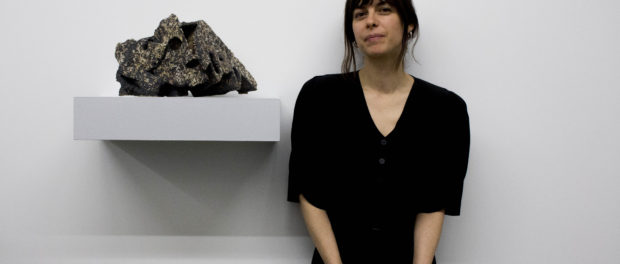But First, Let Me Take a Selfie!
It started with an 3D animation exploring a mountainous landscape made up of photos of Kim Kardashian’s skin.
French-Canadian artist Grégory Chatonsky’s “Perfect Skin II” 2-minute long video is as equally grotesque as it is intriguing, offering a bird’s eye view of an environment covered with detailed patches of Kim K’s flesh.
The video was inspired by an article on self-design by Boris Groys, a professor of aesthetics and art history from Berlin. It was also, as his creative partner Dominique Sirois explained, the starting point for their collaborative project of the same namesake.
“Perfect Skin” opened in Montreal on Jan. 19 at Diagonale, packing an impressive number of bodies into the gallery’s small but cozy space on a chilly evening. Combining the conceptual principles on body-image and self-designation from the original animation with the imperfect nature of urban architecture, Chatonsky and Sirois’ sculptural works provoke a number of questions regarding our current digi-socio climate.
Ocean DeRouchie (OD): Why did you choose Kim Kardashian over a different figure?
Dominique Sirois (DS): Kim is the perfect [example of] someone not having a particular talent and who is, out of that, promoting herself a lot on media platforms. The project broadened on the idea of “the body on the Internet” from there. You can find files of stars and people you don’t know, all these literal skins on the Internet… 3D scans of the body, used for animation. So the project is really on the topic of skins.
OD: Do you think she’s loved, or very much a hated celebrity?
DS: I think she is more loved than hated… We really obsess about people we don’t know, and we kind of get familiar with them as they become a commodity.
OD: Body image and self-love are hot topics on social media, as there’s this huge movement that refuses to conform to beauty standards. How does this project provide commentary on that?
DS: We were pretty neutral except for the fact that there’s kind of an obsession. Everybody’s obsessed with their own body. When you see Kim Kardashian, she’s really obsessed -— maybe more so than others. That’s how we related it to architecture. When it’s not yours, not your skin, you don’t really care. When you have something on your face, you’ll really care. But if it’s not your face, you’ll disengage. That’s how we came to link [skin] with architecture—cracks on the wall no one cares about.

Masks by Dominique Sirois. “These were beauty masks, to have perfect skin. But the texture is a bit deformed. It was taken from around the buildings, part of the concrete crumbling, so I took little bits and did imprints on these masks, to create a tension between wanting to be perfect and have better skin, and just more the architectural reality of imperfection and impersonality.” Photo Ocean DeRouchie.
OD: What’s your personal stance on taking selfies? Is it be empowering?
DS: I think we should be natural about it.
OD: Do you take selfies?
DS: Yeah, I do. But I don’t feel moral about it, I don’t think it’s bad or good. If you want to do it you should do it. The project is absolutely not judgemental or moral about these issues, it’s more of a formal exploration of them.
OD: Some argue that selfies, and the culture that created the phenomenon, is not feminist or is oppressive in its vanity. What do you think?
DS: Is it that women communicate too much with their bodies or that it becomes too important? It’s definitely an issue. Even in art history, the representation of paintings has been more focused on women [as subjects], because the painters were mainly men. And now women can be in control because they take selfies, but it’s just adding to the mass of imagery that is mainly feminine.

Video. Perfect Skin. Photo Ocean DeRouchie.
OD: Are we living in an age of digital consumerism?
DS: I think we’re in a culture where digital consumerism is really powerful, to the point even in art. People are no longer going to galleries [as often], maybe just for the opening. I see a lot of exhibitions online now that I wouldn’t go to because I can’t, and for me sometimes I am thinking, “Oh my god, do I look at books anymore?” On the Internet, what you’ll find is left to chance. It depends on when you’re connected; you’ll fall on certain content. But if you go online 15 minutes later, you might find something completely different. It brings you somewhere. It’s really hyper-present.
OD: What needs to change within these domains?
DS: We should learn how to not want so much. It’s not just a question of too much that is not enough, and where you get lost in that. Personally, I don’t need a lot. I am satisfied with nothing. I would advise that, andt take the time to absorb. There’s a lot in not much.
“Perfect Skin” is running Jan. 19 through March 10 at Diagonale, 5455, avenue de Gaspé, rdc/espace 110.






